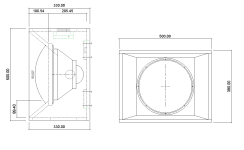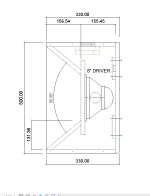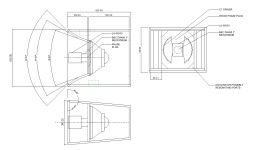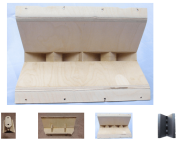Look at the bass bin at the end of the article. A short and fast opening horn:
https://sphericalhorns.net/2023/10/14/the-first-build-of-the-mk3b2-radial-fin-horn/
https://sphericalhorns.net/2023/10/14/the-first-build-of-the-mk3b2-radial-fin-horn/
Or this example made by @DonVK to optimize the power response:
https://www.diyaudio.com/community/...-work-in-progress.326926/page-21#post-6998152
https://www.diyaudio.com/community/...-work-in-progress.326926/page-21#post-6998152
What is the difference between a wave guide and a horn mouth for low/mid? Doesnt the wave guide suffer the same size vs cutoff constraints? or are you talking about a HF wave guide?
The difference between a horn and WG is floating. The main task of a WG is the control of sound dispersion, the increase of spl in the lower range of it is of course welcome. A WG usually does not have a band pass effect like most horns do. A WG opens fast
Horns often have a compression chamber and/or a phase plug, higher spl gain, most open slower and they got a longer mechanical length. The control of the dispersion is one of the most sought after property nowadays too and is often choosen in favor instead of getting higher spl gain.
The volume of the compression chamber determines the upper end of the frequency range of the horn. That also depends on the driver and the construction and type of horn of course and there are exceptions from these criteria.
Ok Im getting close. If possible, please help me narrow this down, I was originally headed towards a "front radiating with a shallow lense" as another user described it in the begining of my journey. But my ambition of loosing rear phase power, blined me LOL
I was thinking a coax would be the fun way to go.
Some of the coaxials are indicating a natural dispersion of 70-80deg, and others 100deg, and I was afraid, maybe unfounded, of introducing some artificial constraint (waveguide) that would ruin the natural coaxial phenomenon.
So the good news Is that Im down to 2-3 fairly similar designs.
Hopeful constants
Plan A
An beefy 8" driver would have a 150+- mm waveguide depth for example.
A beefy 6.5" driver would have a 180 mm waveguide depth for example.
Plan C
wider box?, additional drivers?
Am I splitting hairs here, or am I headed for a realistic target?
(loose!) Schematic plans attached
I was thinking a coax would be the fun way to go.
Some of the coaxials are indicating a natural dispersion of 70-80deg, and others 100deg, and I was afraid, maybe unfounded, of introducing some artificial constraint (waveguide) that would ruin the natural coaxial phenomenon.
So the good news Is that Im down to 2-3 fairly similar designs.
Hopeful constants
- "solid" 90Hz cutoff before roll off.
- stack these like a small cheap line array later down the road to at least gain some coupling, so Im thinking 80deg? horizontal x 15deg+- vertical? More research to do on line arrays...
- I was originally hung up on having them stack on my tham15s (500mm wide) but have changed my tune a little, and am open to these becoming there own thing if there are some real gains, based on this wave guide discussion.
- hoping for a good quality affordable simple top for folks like me who have built diy bass bins, and need a worthy top that has plans, cnc cut sheet and specs.
Plan A
- 12" Coaxial (maybe Eminence Beta-12CX 12" or Celestion FTX1225 12")
- 105mm waveguide length, straight or arc of some kind.
- un-vented
- use a separate 12" LF + shallow HF driver in front as a qasi-coaxial configuration
- line array style HF wave guide? Eminence LA-WG10, with some kind of reverse bullet behind it for flow. Honestly Id love to cnc this HF waveguide out of wood as part Two in this design process.
- same 105mm waveguide length, straight or arc of some kind.
- un-vented
An beefy 8" driver would have a 150+- mm waveguide depth for example.
A beefy 6.5" driver would have a 180 mm waveguide depth for example.
Plan C
wider box?, additional drivers?
Am I splitting hairs here, or am I headed for a realistic target?
(loose!) Schematic plans attached
Attachments
Some of the coaxials are indicating a natural dispersion of 70-80deg, and others 100deg, and I was afraid, maybe unfounded, of introducing some artificial constraint (waveguide) that would ruin the natural coaxial phenomenon.
No, 70-80° is perfectly reasonable, the horn of a coax will not have a wider dispersion anyway.
So the good news Is that Im down to 2-3 fairly similar designs.
Hopeful constants
- stack these like a small cheap line array later down the road to at least gain some coupling, so Im thinking 80deg? horizontal x 15deg+- vertical? More research to do on line arrays...
Uhm, no. These coaxes aren't stackable. The distance from the middle of the driver to the next make it impossible, you get very ugly lobing and interferences. Either you accept the max spl limit of the coax or you need a completely different concept.
Plan A
- 12" Coaxial (maybe Eminence Beta-12CX 12" or Celestion FTX1225 12")
- 105mm waveguide length, straight or arc of some kind.
- un-vented
If you want to use them for PA, both will need the vents for cooling, since they don't have a pole core bore, cooling is more critical than on other drivers. The Eminence is (well, at least over here in Germany) a lot more expensive since you have still to buy the CD on top of it. Eminence: ~160€, Celestion: ~210€ (includes a CD with 45mm VC (bass:63mm vs. 51 emmi) which costs ~100 if you buy it separately.
Plan B
- use a separate 12" LF + shallow HF driver in front as a qasi-coaxial configuration
- line array style HF wave guide? Eminence LA-WG10, with some kind of reverse bullet behind it for flow. Honestly Id love to cnc this HF waveguide out of wood as part Two in this design process.
You can't stack that either except if you put 3 of the LA-WG10 in front of the 12". Each of these needs their own CD too btw.
Here is a single driver with horizontal dispersion angles that seem to feel right, and vertical dispersion that seems common? for a line array coupling effect, and can be notch CNC'd to meet a mathematical arc of some kind if it helps., and a phase plug.
There is cooling in the form of front ports that can be resonators if there end up being enough volume.
I realize that the I need another HF driver and guide, and even that is probably not enough. Im hoping to look into CNCing a HF wave guide to fit this design top to bottom that uses only 1 HF driver.
At this point Im just trying to get close to something that has a percentage of being successful. It seems like all my other sketches end up as duds. But Im feeling Like there is some practicality to this one.
Any comments suggestion are very welcome.
There is cooling in the form of front ports that can be resonators if there end up being enough volume.
I realize that the I need another HF driver and guide, and even that is probably not enough. Im hoping to look into CNCing a HF wave guide to fit this design top to bottom that uses only 1 HF driver.
At this point Im just trying to get close to something that has a percentage of being successful. It seems like all my other sketches end up as duds. But Im feeling Like there is some practicality to this one.
Any comments suggestion are very welcome.
Attachments
To get the best performance from horns, considering their complexity, you want to define the outcome parameters clearly and you want to model it.
For example, directivity has a different meaning for hifi compared to PA, so discussions might lose focus. In simplest terms, Hifi is more interested in keeping off walls. PA is more interested in not playing to empty seats and focussing the sound where it is needed for greater output.
Hifi also might want to avoid loading, where as PA wants to get more output.
In addition to this, you want to consult software like hornresp. If I were you I'd do the following three things...
1. Start a thread in the PA section of the forum (this is a hifi section). Here they might advise a design which is compact, folded and high output.
2. Define your bandwidth.. the smaller, the easier it might be to get results in practice. Define your priority of high output. Define the space you're playing to..
3. Get on the hornresp thread and get guidance in modelling your ideas then show the results and get feedback - https://www.diyaudio.com/community/threads/hornresp.119854/unread
For example, directivity has a different meaning for hifi compared to PA, so discussions might lose focus. In simplest terms, Hifi is more interested in keeping off walls. PA is more interested in not playing to empty seats and focussing the sound where it is needed for greater output.
Hifi also might want to avoid loading, where as PA wants to get more output.
In addition to this, you want to consult software like hornresp. If I were you I'd do the following three things...
1. Start a thread in the PA section of the forum (this is a hifi section). Here they might advise a design which is compact, folded and high output.
2. Define your bandwidth.. the smaller, the easier it might be to get results in practice. Define your priority of high output. Define the space you're playing to..
3. Get on the hornresp thread and get guidance in modelling your ideas then show the results and get feedback - https://www.diyaudio.com/community/threads/hornresp.119854/unread
Last edited:
(Glad I missed the arguing.)
I think well-controlled backwave midrange horn output would be "well-mixed" i.e. closer to OB 1.5m from irregular room-boundaries (~3m additional path-length with chaotic variance) and time-delayed ~10ms, which is not "heard" as simple summation/cancellation/smearing with/of the direct output. At lower bass frequencies this (well-known) effect adds "venue" spatial-ness; at midrange, possibly "openness". (The classic Diatone P-610 cab is often described as half-BR/half-OB and does sound very "open".)
(DX55; DX3; PM6A; PM2A Ticonal in Fidelio)
I think well-controlled backwave midrange horn output would be "well-mixed" i.e. closer to OB 1.5m from irregular room-boundaries (~3m additional path-length with chaotic variance) and time-delayed ~10ms, which is not "heard" as simple summation/cancellation/smearing with/of the direct output. At lower bass frequencies this (well-known) effect adds "venue" spatial-ness; at midrange, possibly "openness". (The classic Diatone P-610 cab is often described as half-BR/half-OB and does sound very "open".)
(DX55; DX3; PM6A; PM2A Ticonal in Fidelio)
Last edited:
Any comments suggestion are very welcome.
Your new drawing/plan of the speaker includes the Eminence LA-WG10. If you don't build a (real) line array, you will not be happy with its behaviour. It disperses the sound 140° x 15°, that is extremely wide horizontal and extremely narrow vertical, practically laser sharp vertically. I still don't know what you want to do with such a speaker and with such a dispersion the use of it is limited to just very rare circumstances. Before making further plans it would be a good idea to define the requirements of the speaker(s).
- Use (PA? Home-HiFi?)
- likely room/venue size, # of audience
- dispersion requirements
- needed spl
- size requirements (truckspace) and weight limit (if moved often)
I guess it would be interesting to try a wooden horn extension in front of a line-array waveguide.It disperses the sound 140° x 15°, that is extremely wide horizontal and extremely narrow vertical, practically laser sharp vertically.
Regards
Charles
Im not in any understanding on the wood horn image attached, but I feel like something like it can be done in a ..reasonably useful way...
That might actually be part of the mission statement of this design objective "reasonably useful way"
My scope has been a moving target, because as I get feedback on the reality of physics, the design objective changes.
I Im going to post an update to the objective, to help us all hone in on design outcomes..
PS wchang I appreciate your comment but I cant internalize it. could you bring it into a more general layman form/feeling/result?
That might actually be part of the mission statement of this design objective "reasonably useful way"
My scope has been a moving target, because as I get feedback on the reality of physics, the design objective changes.
I Im going to post an update to the objective, to help us all hone in on design outcomes..
PS wchang I appreciate your comment but I cant internalize it. could you bring it into a more general layman form/feeling/result?
Attachments
Im not in any understanding on the wood horn image attached, but I feel like something like it can be done in a ..reasonably useful way...
That might actually be part of the mission statement of this design objective "reasonably useful way"
Well, that is a horn for a flat wave front, for a line array. It's made for 2 drivers.
My scope has been a moving target, because as I get feedback on the reality of physics, the design objective changes.
Well, the problem with that is, every time you're changing your target, all the help and time invested up to that point is wasted. Every time you see a new shiny thing, you want it.
That makes helping you not especially rewarding.
Tell what you need to do. If you don't have anything to describe what you want, nobody can actually help you. I feel I have invested enough efforts, I'll concentrate on other things in the forum now.
@turboblast(Glad I missed the arguing.)
I think well-controlled backwave midrange horn output would be "well-mixed" i.e. closer to OB 1.5m from irregular room-boundaries (~3m additional path-length with chaotic variance) and time-delayed ~10ms, which is not "heard" as simple summation/cancellation/smearing with/of the direct output. At lower bass frequencies this (well-known) effect adds "venue" spatial-ness; at midrange, possibly "openness". (The classic Diatone P-610 cab is often described as half-BR/half-OB and does sound very "open".)
(DX55; DX3; PM6A; PM2A Ticonal in Fidelio)
In layman terms -- I was pointing out the long horn-path delays backwave by ~10ms (like an open-baffle speaker ~1.5m from wall whose backwave takes that long to bounce back to the baffle/driver), and furthermore the backwave bouncing around inside the horn is (again) like open-baffle backwave bouncing off furnishing etc. People like OB sound for "openness" (whatever that term means) so midrange backwave leaking out the horn mouth is not necessarily terrible, if well controlled (as @flex2 pointed out). The ~10ms delay is interpreted by ear/brain as natural echo present at the original recording venue (sense of space), not as a distortion/interference/smearing of the music transcient attack.
...horn-path delays backwave by...
An odd number of half wavelengths.
dave
People like OB sound for "openness" (whatever that term means) so midrange backwave leaking out the horn mouth is not necessarily terrible
That 'openness' is created by the scattered back sound, especially in the mids and heights. Despite the numerous claims of OB fans, that is not only possible with an OB but also with a back or top firing driver. That makes the 'boxy' sound of non-OB speakers go away instantly. What I cannot fathom is why these OB fans are so inconsequential and use more often than not tweeters that aren't dipoles or add a back tweeter or even use a horn for that, which reduces the 'openness' even more by the narrower dispersion. Don't misunderstand me, OB can sound amazing but if you like that, then why not follow the principle throughout and not stop in the middle (well, in this case, literally)?!
The back radiated sound doesn't have to be completely controlled, it's scattered by the back wall, furniture, ceiling etc anyway which you can't control in any way unless you remove all those objects, which leaves you in a practically empty room. What you can and should do is to keep an eye on the energy over the frequency in the room. If there's a big discrepancy between the direct radiated sound and the reflection (ie OB and horn tweeter), then you are doing something quite wrong. If you want the energy bilance in the room somewhat coherent, combine the front facing horn tweeter with a wide dispersing back tweeter. The big advantage you have in a non-OB dipole (by back firing drivers) is, you can easily adjust the 'openness' by the level of the back firing drivers or even equalizing them - which is not possible by an OB.
Possibly because "fullrange" drivers already tend to shout ~8khz and any more treble 6-10khz would be unbearable.why not follow the principle throughout and not stop in the middle
Thanks for the detailed reply. The word that escaped me was "scatter".
It's spread and reflected at a lot different run path lengths. That results in spread and semi-random reflections. Don't mind me using these words, my english might seem acceptable or even good but I still make a lot (sometimes very embarrassing) mistakes. Don't hesitate to ask for something to be explained. There's no shame it it and I always appreciate if someone wants to learn something.
The intent is
Feeling a little lost Im starting to just look at a 12" Beta instead of a BnC coax with a danley style sm80 style wave guide. or a basic BassBoss coax in a box. Would be nice if there was a way to stack these and get some coupling gains at least.
Im avoiding ports because I dont like how they sound in the listing field. They seem to sound like their own little localized mud pile, disconnected from everything elase. But they might be a nessesary evil to get the extension. If there was a way to couple them into the coax sound field I would do that in a heartbeat.. but I doub its possble.
- PA use
- 4 Cabs that can be pole mounted in a quadraphinc configuration, or stacked, or just used in a stereo pair
- sometimes used with tham15's, some times not
- get some bass extension without ports
- integrate bass into the image
- full range
- some projected image so that people feel like they are in the music
- use is for higher spl disco and sometimes ambinet
Feeling a little lost Im starting to just look at a 12" Beta instead of a BnC coax with a danley style sm80 style wave guide. or a basic BassBoss coax in a box. Would be nice if there was a way to stack these and get some coupling gains at least.
Im avoiding ports because I dont like how they sound in the listing field. They seem to sound like their own little localized mud pile, disconnected from everything elase. But they might be a nessesary evil to get the extension. If there was a way to couple them into the coax sound field I would do that in a heartbeat.. but I doub its possble.
The intent is
- PA use
- 4 Cabs that can be pole mounted in a quadraphinc configuration, or stacked, or just used in a stereo pair
- sometimes used with tham15's, some times not
- get some bass extension without ports
- integrate bass into the image
- full range
- some projected image so that people feel like they are in the music
- use is for higher spl disco and sometimes ambinet
The expectations contradict each other. A speaker which performs well alone will not be able to perform as well in a LA stack. Either you get different speakers for different occasions or you will experience an immense loss of performance. A LA element will never perform half-way acceptable as a fullrange speaker. The differences in requirements are so vast, a compromise to serve both requirements will result in 10-20dB maxspl loss. That's a magnitude you can never ever make up with power. "One size fits all" doesn't apply in PA. If that would be possible, you'd find it on the market, it would sell like sliced bread.
You can build a "one size fits most sized" though. But unless you understand the differences and requirements of each requirement, you will never get a suitable PA for your needs.
Or in other words: What you want does not exist and can't be made!
Well, maybe it can in the future but that would require immense advancements in driver technoligy which isn't expected within the next ~30 years.
Im trying not to just throw money at expensive drivers and power, in hopes that there is some acoustic effect via cabinet deign that would give me some gains and throw. But the box gets to big, and trend seems to be hot and heavy front radiating.
See, to have a PA for 50-200 ppl is easy and cheap, if you want to have sound for 500 ppl, it's only a bit over the cheap stuff but you have to pick the right stuff and if you want to get up to 1000-1500 ppl, you have to get serious gear. That doesn't exclude DIY but it requires exact planning and using your tools (speakers). Above 800-1,5k ppl you definitely need delay lines, no matter if you use horn speakers or LAs. On numbers above that you need so much precise calculations, several delay-lines and dispersion control you can not manage without professional sound reinforcement software (well, if you're inexperienced, probably even above 500 PAX)
Feeling a little lost Im starting to just look at a 12" Beta instead of a BnC coax with a danley style sm80 style wave guide. or a basic BassBoss coax in a box. Would be nice if there was a way to stack these and get some coupling gains at least.
Forget about these large coax drivers if you want to stack them. It's not possible. Stacking them gets you gains in the low mids but above it's worse than driving a solo coax bin. No, I'm not joking!
Im avoiding ports because I dont like how they sound in the listing field. They seem to sound like their own little localized mud pile, disconnected from everything elase. But they might be a nessesary evil to get the extension. If there was a way to couple them into the coax sound field I would do that in a heartbeat.. but I doub its possble.
Ports sound bad above ~100Hz. If you think the ports sound bad in the bass, then your sub stacking sucks or you just don't have enough of them. Also, 2 side sub stacks is the worst configuration you can have - EVER! If xou don't have any bass dispersion plans, build a mono-stack in the middle. If you have control over the number of subs and xo frequency, build a tooth row!
If either of these, or a simple 2 way gives you what you need you will increase the chances of success. Your work to cross them will be closer within your reach. So far you've been experiencing the overabundance of choices which will gladly lead to confusion. Anyone will find that it takes time to learn and understand.Feeling a little lost Im starting to just look at a 12" Beta instead of a BnC coax with a danley style sm80 style wave guide.
Until then you can either copy something you like or keep it simple and take your own control of the outcome.
- Home
- Loudspeakers
- Multi-Way
- insane question: can a tractrix horn be folded?



